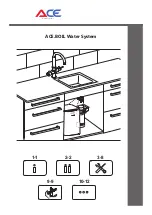
Revision 10
17
Air Supply Fitting Design
The Air supply fitting type like the external muffler design is field retrofittable. For this
type of leak detection the air supply elbow (the elbow fitting which is the furthest from the
center of the head) should be removed. The “T” fitting should then be screwed into it’s
place. For 5 GPM pumps it may be necessary to turn the opposite elbow (shift air elbow)
so that it is facing away from “T” fitting NPT port. The “T” fitting can then be easily
screwed into the head until it almost bottoms out. The gripper fitting part of the “T” should
point back towards the shuttle. The air supply tube can now be reconnected to the
gripper fitting portion of the “T” fitting. The supplied leak detect adapter can then be
screwed into the 1/8” npt port of the “T” fitting. The remaining 1/8” npt port on the leak
detect adapter should be plugged unless this port is being used for pressure switch
stroke detection of the pump. Next remove the PFA Leak Detect Probes from the PFA
encapsulated fibers and screw them into the open ports until they become snug. The
PFA encapsulated fibers can then be re-inserted back into the probes until they bottom
out. The gripper nuts can then be tightened up to lock the PFA encapsulated fibers into
place.
Conductivity Leak Detection probes
The conductivity leak detection probes have the same thread connection as the fiber
optic leak detect probes. As such they can be screwed into the same port as the fiber
optic leak detect probes.
The conductivity leak detect probes should not be used in explosion proof environments
such as with solvent applications.
Summary of Contents for AT100
Page 2: ...Revision 10 1 ...
Page 12: ...Revision 10 11 AT Series Pump Exploded View ...
Page 32: ...Revision 10 31 Surgeless Pulsation Dampeners By White Knight SL100 ...
Page 37: ...36 ...
Page 38: ...37 ...
Page 39: ...38 ...
Page 40: ...39 ...
















































